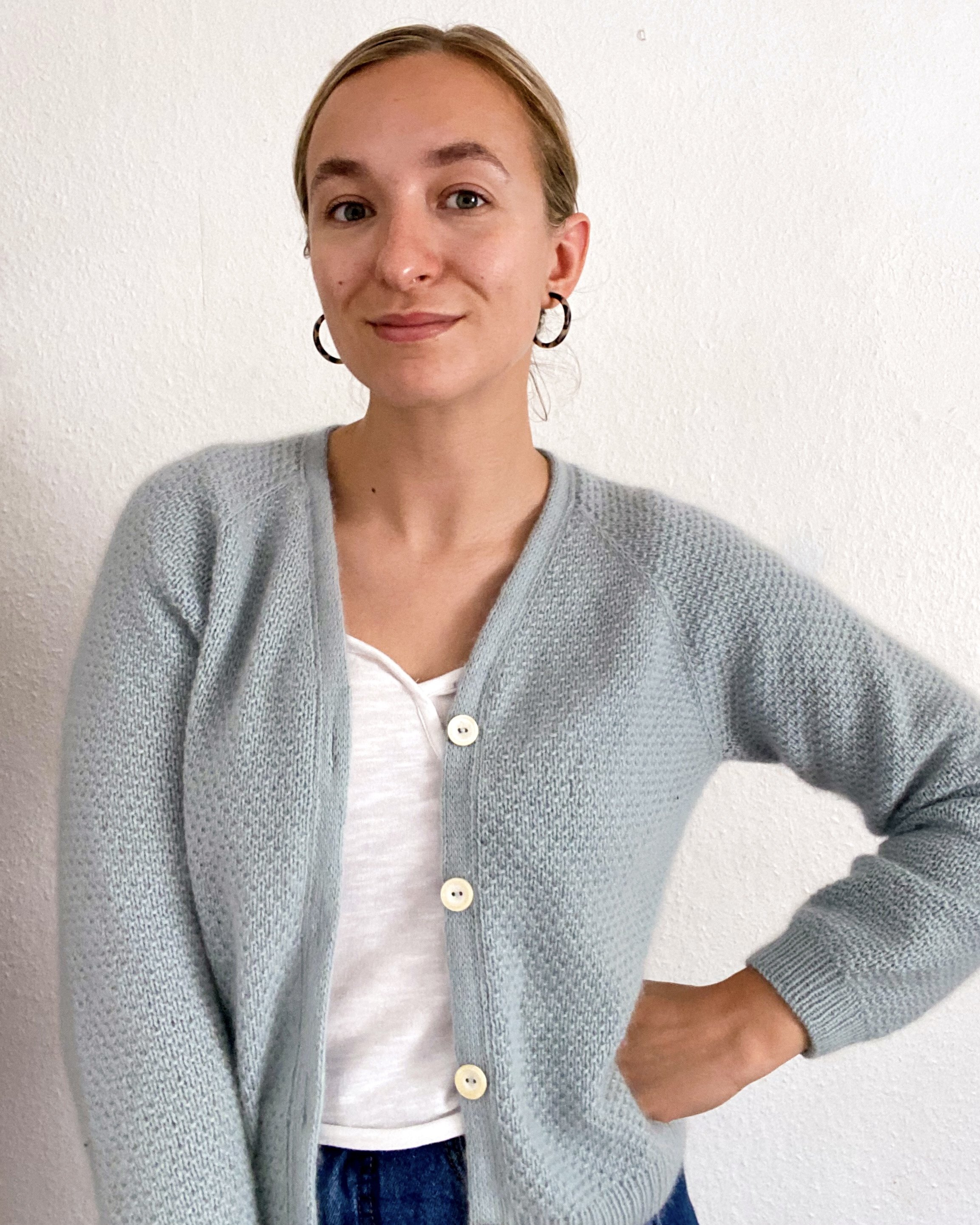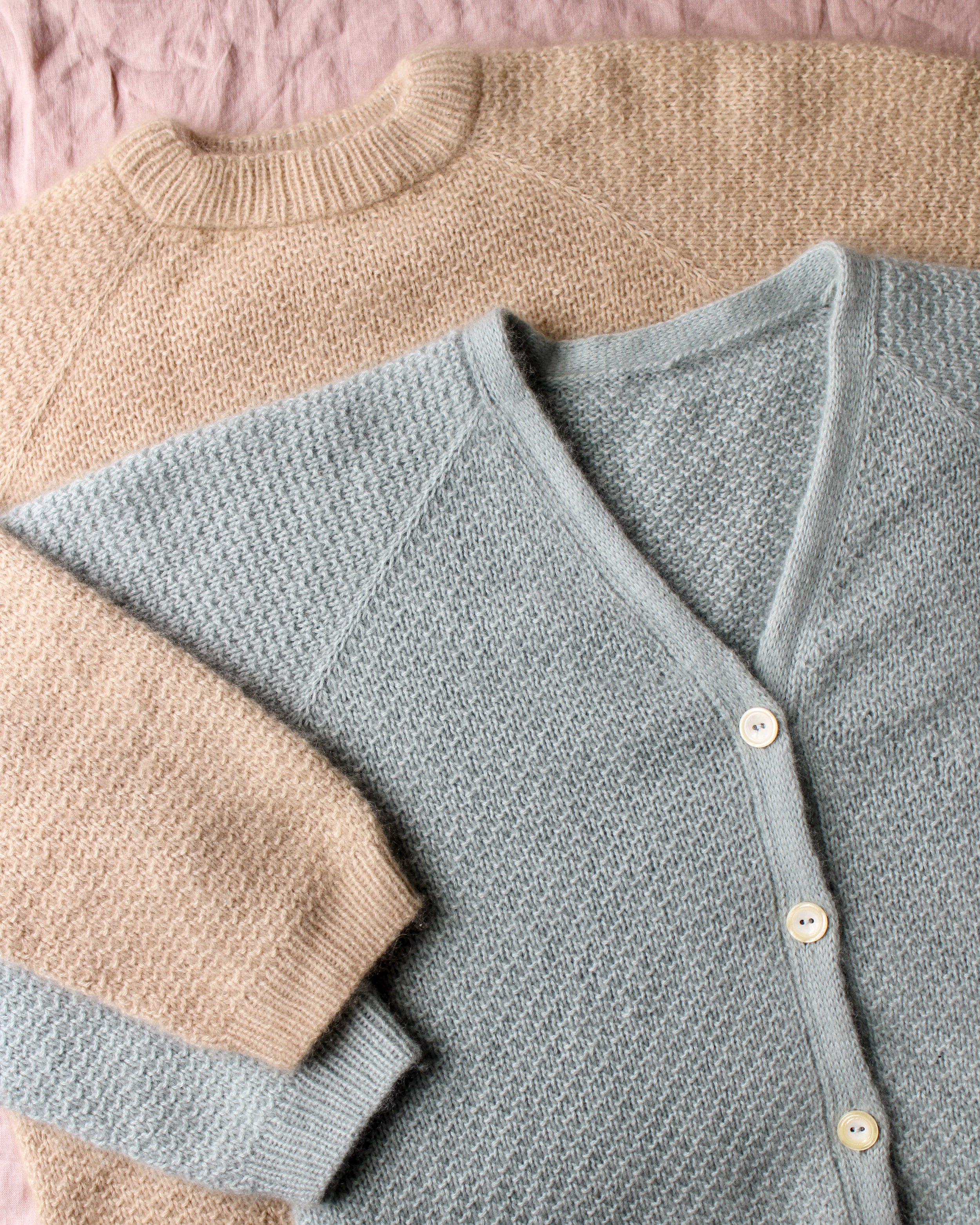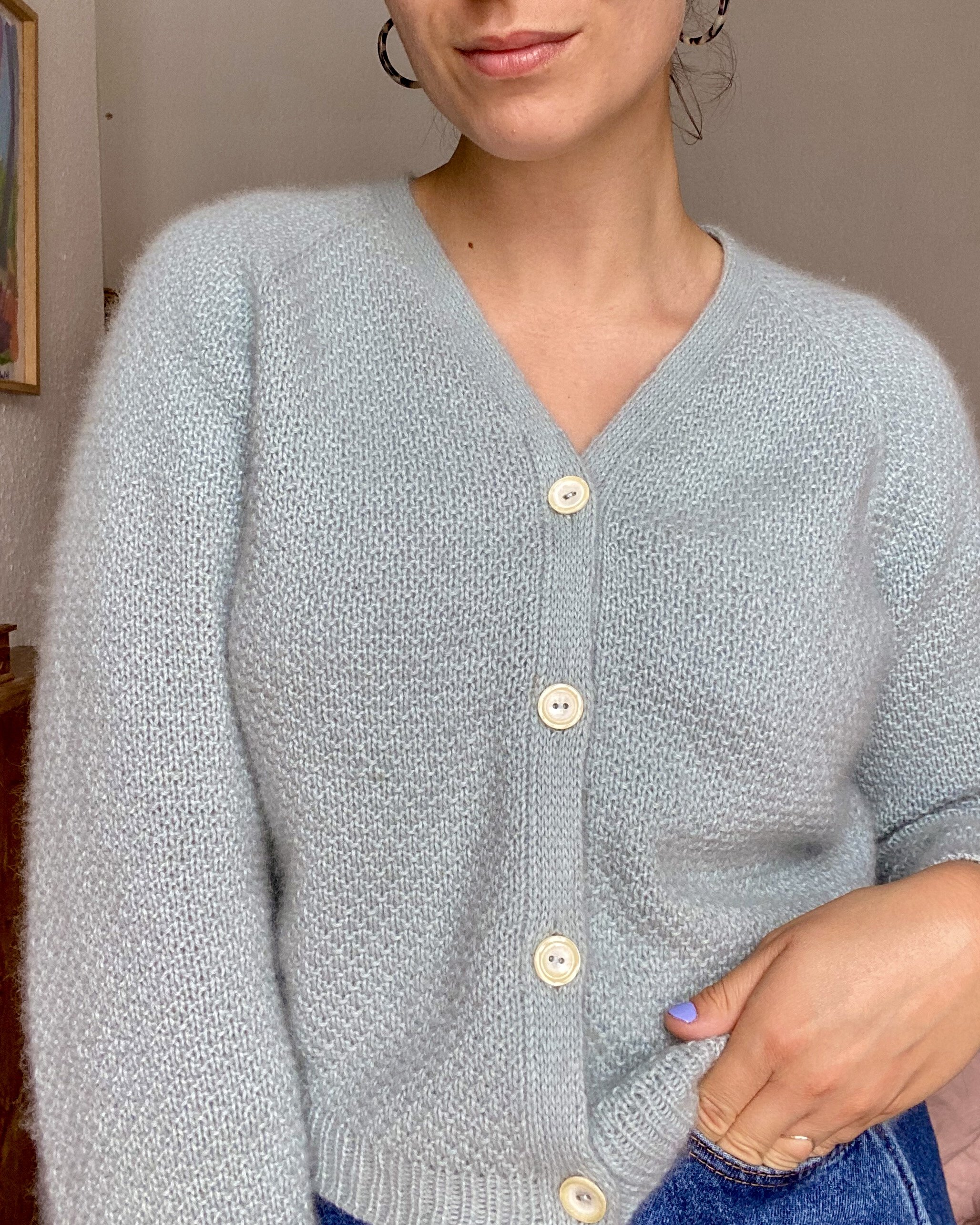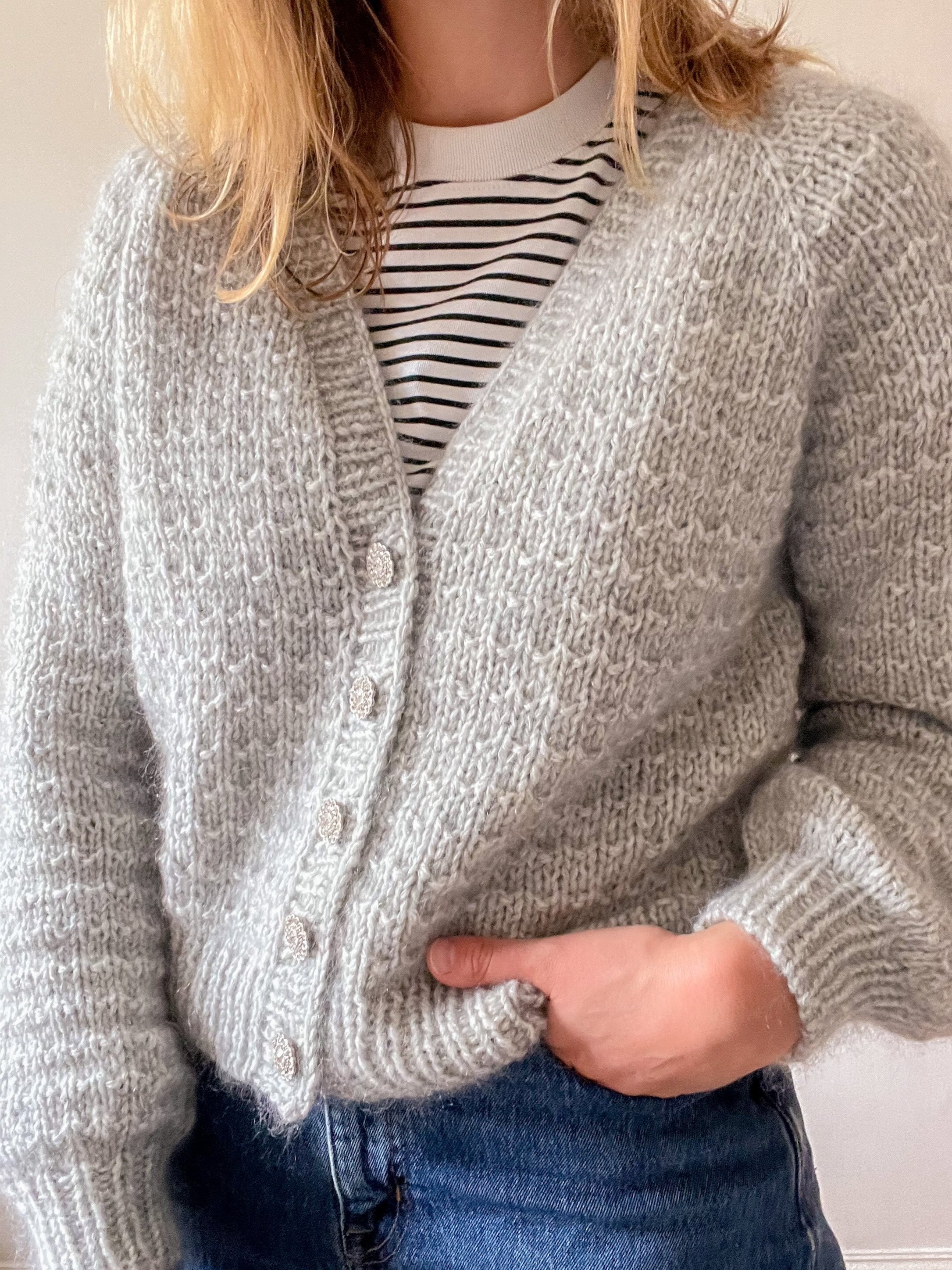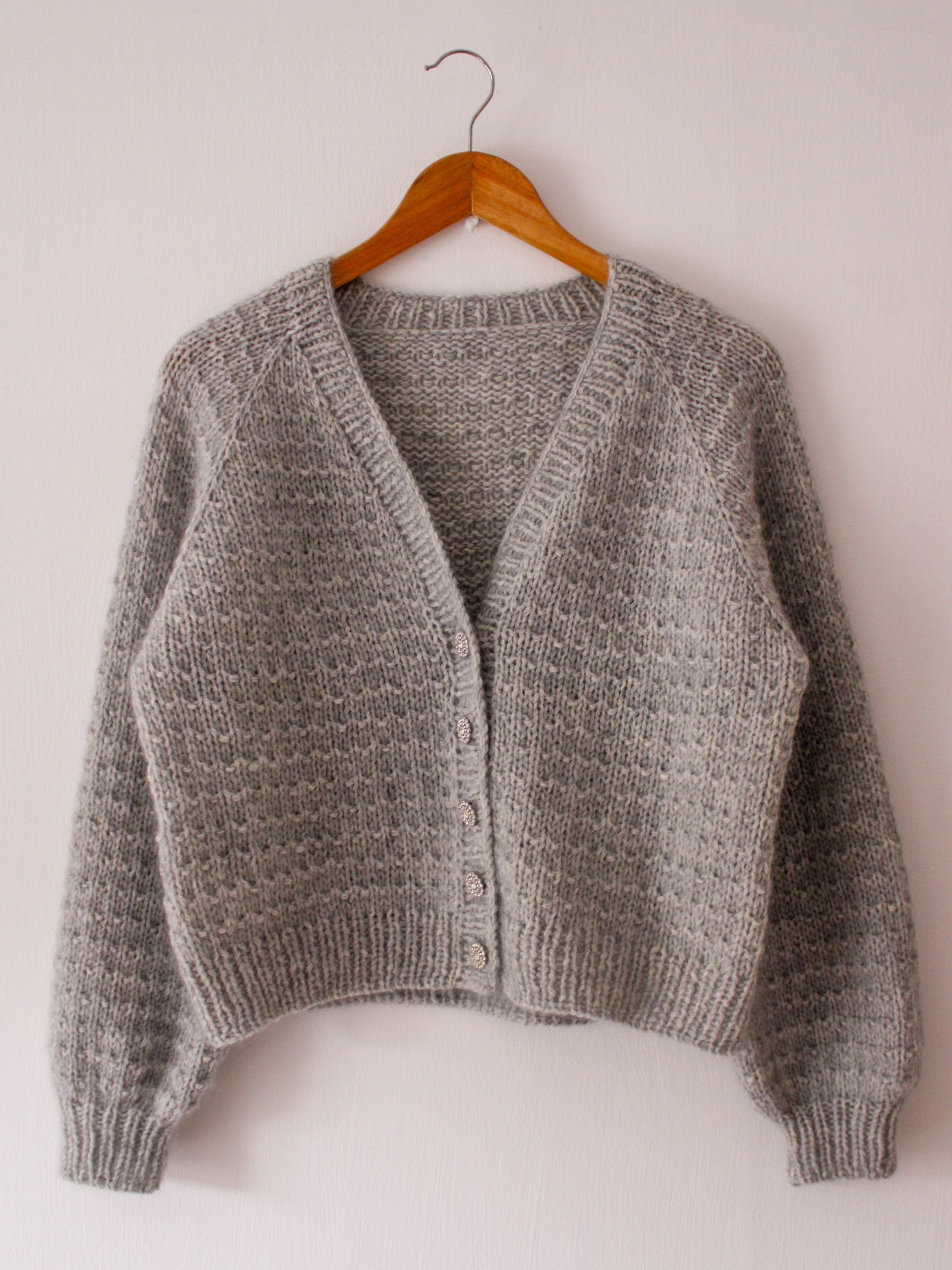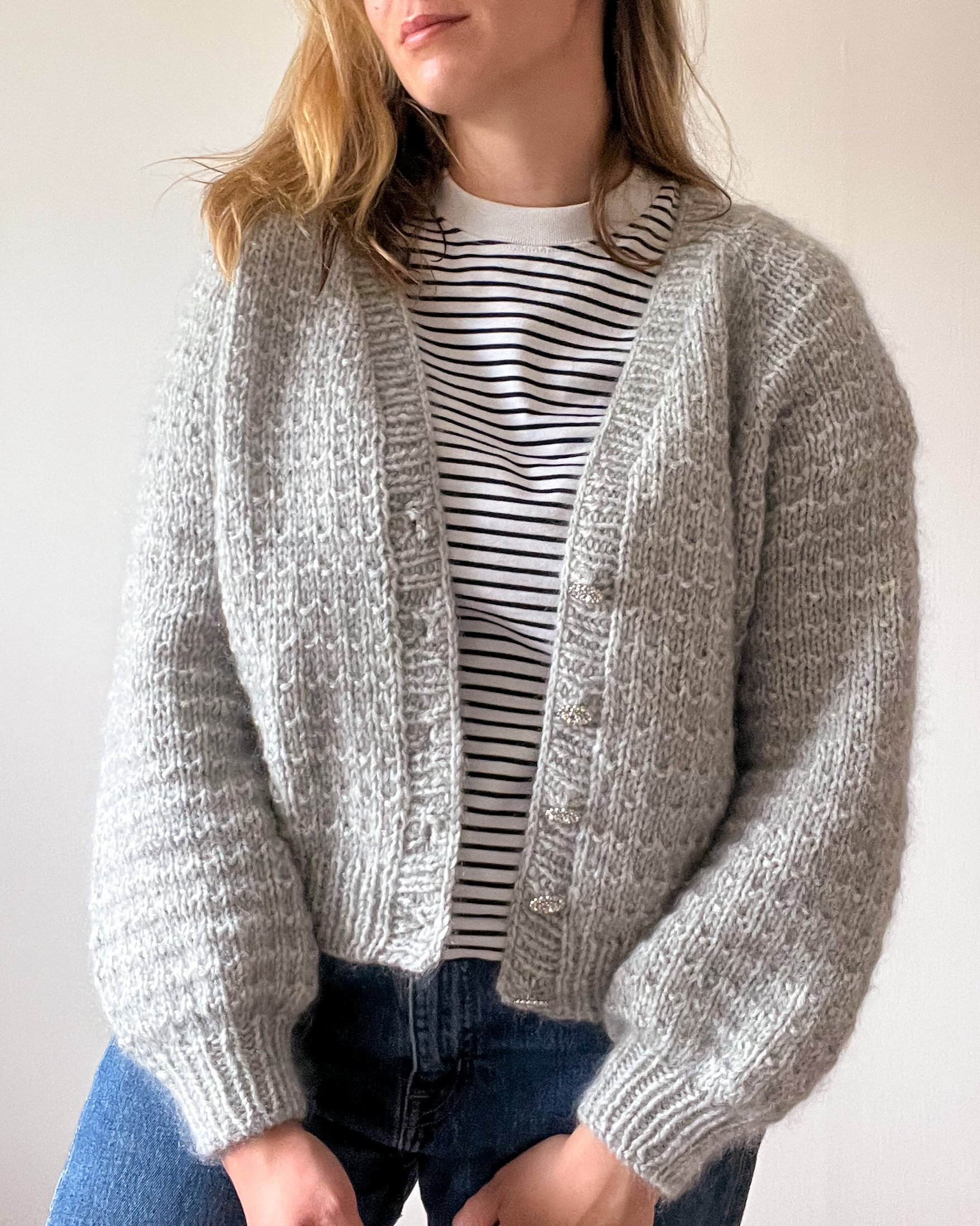Pippin Cardigan
The Pippin Cardigan is a classic raglan cardigan with a textured twist. The sand stitch pattern looks impressive but is surprisingly easy to work. It is named after my sweet cat, Pippin, who tried to eat my yarn at every opportunity. I hope you'll like the cardigan as much as he does!
The cardigan itself is worked in sand stitch using a DK-weight yarn or a combination of fingering- and lace-weight yarns. The yoke and body are worked top-down and flat, but the sleeves are worked in round. Once the yoke is finished, you will leave the sleeves to rest and work the body to your desired length. You will then pick up the stitches for the sleeves and work them with some gentle decreases to create a slight taper. I recommend that you finish the body and sleeves with tubular cast-offs, but you can use your preferred method. You will then work a button band in double knitting.
This is a pattern of intermediate to advanced difficulty. The construction uses a compound raglan, meaning that the increase rate changes throughout the yoke for each size to achieve a good fit. This is quite straightforward in practice but it can make the written instructions look more complicated. You will also need to be able to maintain the sand stitch pattern throughout the cardigan. Double knitting can feel difficult but it becomes intuitive quite quickly. Swatching is a must.
Please note that this is a digital pdf and not a physical knitting pattern. Many thanks to Rebecca Williamson for tech editing this pattern.
The Pippin Cardigan is a classic raglan cardigan with a textured twist. The sand stitch pattern looks impressive but is surprisingly easy to work. It is named after my sweet cat, Pippin, who tried to eat my yarn at every opportunity. I hope you'll like the cardigan as much as he does!
The cardigan itself is worked in sand stitch using a DK-weight yarn or a combination of fingering- and lace-weight yarns. The yoke and body are worked top-down and flat, but the sleeves are worked in round. Once the yoke is finished, you will leave the sleeves to rest and work the body to your desired length. You will then pick up the stitches for the sleeves and work them with some gentle decreases to create a slight taper. I recommend that you finish the body and sleeves with tubular cast-offs, but you can use your preferred method. You will then work a button band in double knitting.
This is a pattern of intermediate to advanced difficulty. The construction uses a compound raglan, meaning that the increase rate changes throughout the yoke for each size to achieve a good fit. This is quite straightforward in practice but it can make the written instructions look more complicated. You will also need to be able to maintain the sand stitch pattern throughout the cardigan. Double knitting can feel difficult but it becomes intuitive quite quickly. Swatching is a must.
Please note that this is a digital pdf and not a physical knitting pattern. Many thanks to Rebecca Williamson for tech editing this pattern.
The Pippin Cardigan is a classic raglan cardigan with a textured twist. The sand stitch pattern looks impressive but is surprisingly easy to work. It is named after my sweet cat, Pippin, who tried to eat my yarn at every opportunity. I hope you'll like the cardigan as much as he does!
The cardigan itself is worked in sand stitch using a DK-weight yarn or a combination of fingering- and lace-weight yarns. The yoke and body are worked top-down and flat, but the sleeves are worked in round. Once the yoke is finished, you will leave the sleeves to rest and work the body to your desired length. You will then pick up the stitches for the sleeves and work them with some gentle decreases to create a slight taper. I recommend that you finish the body and sleeves with tubular cast-offs, but you can use your preferred method. You will then work a button band in double knitting.
This is a pattern of intermediate to advanced difficulty. The construction uses a compound raglan, meaning that the increase rate changes throughout the yoke for each size to achieve a good fit. This is quite straightforward in practice but it can make the written instructions look more complicated. You will also need to be able to maintain the sand stitch pattern throughout the cardigan. Double knitting can feel difficult but it becomes intuitive quite quickly. Swatching is a must.
Please note that this is a digital pdf and not a physical knitting pattern. Many thanks to Rebecca Williamson for tech editing this pattern.
Materials & Fit
Notions: 3 mm [US 2.5] (40- and 80-/100-cm [16-, 32-, and/or 40-in] cord) and 4 mm [US 6] (40-, 60-, 80-, and/or 100-cm [16-, 24-, 32-, and/or 40-in] cord) circular needles. I would strongly recommend having sets of 3 mm [US 2.5] and 3.5 mm [US 4] double-pointed knitting needles for the button band. You will also need 8 stitch markers, one of which should be in a contrasting colour, and at least one clip-on stitch marker, a darning needle, some shirring elastic for the collar, and some spare needles/scrap yarn/stitch holders on which the stitches of the sleeves will rest.
Yarn: Approximately 10 (11) 12 (12) 13, (14) 15 (15) 16 (17) 19 skeins of Cardiff Cashmere Classic (100% cashmere; 112 m [122 yds] /25 g). The sample garment was made in Size D in the colour 509 Silver Beige.
This works out to be 1120 (1232) 1344 (1344) 1456, (1568) 1680 (1680) 1792 (1904) 2128 m [1225 (1347) 1470 (1470) 1592, (1715) 1837 (1837) 1960 (2082) 2327 yds] of yarn.
Where possible, buy more yarn than you need to avoid issues with dye lots.
Yarn alternatives: Any light DK/sport-weight yarn with good stitch definition will be a good option here. Kremke Soul Wool Eco Cashmere (100% cashmere; 112 m [122 yds]/25 g) is a good alternative used by some test knitters. Lamana Como (100% merino wool; 120m [131 yds]/25 g) is the right weight and knits up similarly to Cardiff Cashmere Classic. Woolyknit DK Warth Mill British Wool Balls (100% British wool; 204 m [223 yds]/100g) will achieve the correct gauge but will produce a heavier and coarser fabric. Test knitters had a lot of success using a combination of fingering-weight wool with a single strand of mohair. Please note that if you choose to use 2 strands of yarn together, you will need the same quantity of both yarns.
Tension: 22 sts x 34 rows and rounds in sand stitch on 4 mm needles = 10 x 10 cm [4 x 4 in]. Make sure to wash and block your swatch for the most accurate results. Please note that I have tighter-than-average row gauge, but this isn’t too important in this pattern. You may wish to go up or down a needle size, working in 0.25/0.5 mm [US 0.5-1] increments as needed to meet gauge.
14 sts x 34 rows in double knitting on 3 mm [US 2.5] or 3.5 mm [US 4] needles = 2.5 x 10 cm [1 x 4 in]. I would strongly recommend picking up stitches along one edge of your sand stitch swatch to check how your tension varies between the two stitches and to practise picking up stitches for the button band.
Sizing and ease: The Pippin Cardigan has about 4.5-11 cm [1.75-4.25 in] positive ease for Sizes A-H, and 4.5-15 cm [1.75-6 in] positive ease for Sizes I-K. If you would like a closer fitting or looser garment, size up or down accordingly.
Size: A (B) C (D) E, (F) G (H) I (J) K
Chest measurement (cm): 75-80 (80-85) 85-90 (90-95) 95-100, (100-105) 105- 110 (110-115) 115-125 (125-135) 135-145
Chest measurement (in): 29.5-31.5 (31.5-33.5) 33.5-35.5 (35.5-37.5) 37.5- 39.25, (39.25-41.25) 41.25-43.25 (43.25-45.25) 45.25-49.25 (49.25-53.25) 53.25-57
Actual circumference of garment (cm): 85.5 (91) 94.5 (100.5) 105.5, (109.5) 114.5 (120.5) 129.5 (140) 149.5
Actual circumference of garment (in): 33.75 (36) 37.25 (39.5) 41.5, (43) 45.25 (47.25) 51 (55.25) 58.75
Approximate depth of the V-neck, before button band (cm): 13 (14) 14 (15.5) 14, (14) 17.5 (19) 20 (21) 21
Approximate depth of the V-neck, before button band (in): 5 (5.5) 5.5 (6) 5.5, (5.5) 6.5 (7.5) 7.75 (8.25) 8.25
Recommended length of cardigan measured from bottom of collar to bottom of hem along the mid-back (cm): 46 (46) 46 (48) 48, (51) 52 (52) 54 (54) 57
Recommended length of cardigan measured from bottom of collar to bottom of hem along the mid-back (in): 18 (18) 18 (19) 19, (20) 20.5 (20.5) 21.25 (21.25) 22.5
Please note that there is an option to deepen the V-neck included in the pattern, and that some measurements have been rounded to the nearest quarter unit.


